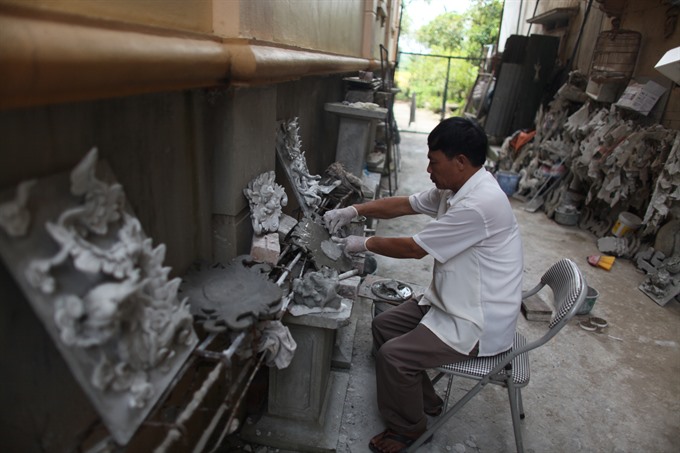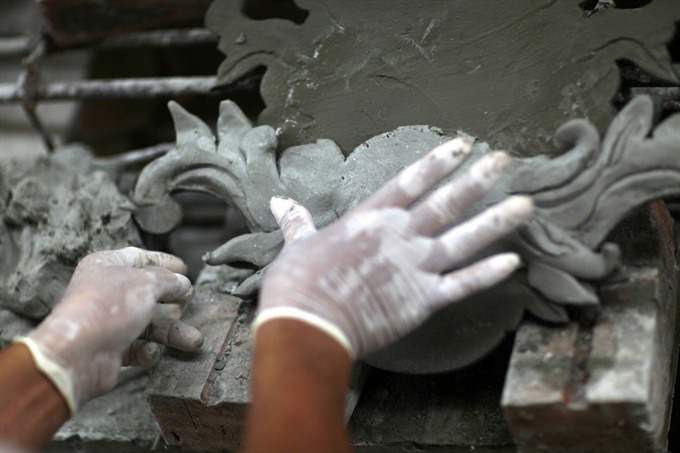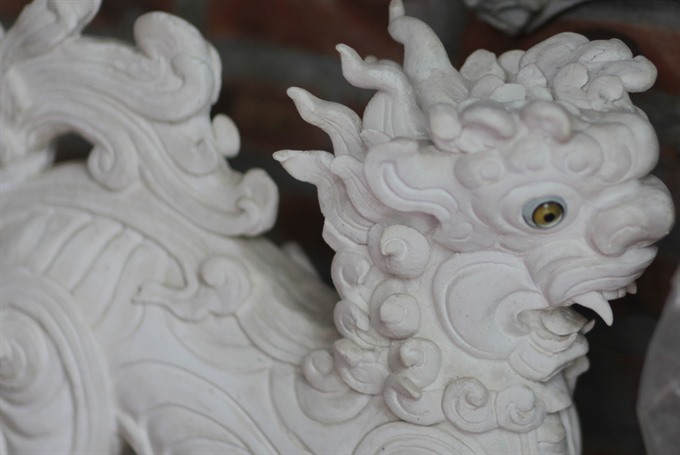 Features
Features

Artisan Nguyễn Văn Tuấn has been determined to preserve and promote bas-relief, the tradtional craft of his hometown, for decades. Utilising the special materials of bas-relief, he has created beautiful 3D pictures. Lương Thu Hương reports.
 |
| Traditional art: Most of the time Tuấn can be seen working in the small workshop next to his house. VNS Photos Trần Hoàng Nam. |
by Lương Thu Hương
Considered an oldest religious building in Việt Nam, Tây Phương Pagoda in Thạch Xá Commune on the outskirts of Hà Nội impresses many visitors with its unique sculptures, especially the statues of holy creatures at its base.
The sophisticated statues were created by the skillful craftsmanship of the local inhabitants. Over the years, the descendants of those talented artisans have taken up the ancestral work of preserving and embellishing the precious statues, one of whom is 62-year-old Nguyễn Văn Tuấn.
Besides prevervation work at Tây Phương Pagoda, Tuấn has designed, restored, and embellished hundreds of religious works in many historical and cultural sites nationwide, notably the Dragon bas-relief in Thầy Pagoda, and the pillar and statues of holy creatures of Hòe Nhai Pagoda, one of the relics celebrating the millennial anniversary of Hà Nội.
Tuấn’s introduction to the job was when he was a 13-year-old observing his grandfather and father, who were carving artisans themselves, making sculptures for religious buildings.
His passion for the job grew over time and eventually led to the creation of his own works.
 |
| Delicate work: The uniqueness of Thạch Xá’s bas relief lies in its materials and the skillful hands of the artisans. VNS Photos Trần Hoàng Nam. |
Unfortunately, during the war, the traditional craft of bas-relief in the Thạch Xá Commune gradually fell into obscurity, as many artisans had to leave home and head for the battlefields.
In 1976, after returning home from combat, Tuấn decided to continue in the footsteps of his father, aspiring to resurrect the traditional work of his hometown, which was at risk of being lost forever. While learning from veteran artisans, he also drew upon his own experiences, to hone his skills and perfect his work.
Gradually, his reputation has spread far and wide. Since 1980, Tuấn has received commissions to restore and embellish many buildings of high historical and cultural significance nationwide.
He says it is the materials that make the traditional craft of bas-relief in Thạch Xá Commune unique, having been produced in the same way for over 200 years by the first artisans.
The materials involved in a bas-relief include hand-made poonah paper, lime and molasses. After the paper has been soaked in lime, it is mixed with molasses and ground thoroughly to create a plaster-type mixture, which is then used to create beautiful work, able to endure any weather conditions.
 |
| Rural scene: A 3D bas relief picture by artisan Nguyễn Văn Tuấn portrays the peaceful rural landscape of Việt Nam. VNS Photo Lương Thu Hương |
On receiving a new commission, Tuấn has to travel to do his work. If the work involves creating new pieces, he has to carefully study the scale and the history of the setting, in order to resurrect the bas-relief work to its original quality.
All the statues of holy creatures that have been created and restored by Tuấn were made during the Trần, Lê, and Nguyễn dynasties of centuries ago, and up until now only existed in the imagination; however, the artisan works skillfully to bring them to life.
“In order to pursue the job, the bas-relief artisans must at least have a gift, passion, determination and patience,” he says.
Utilising the traditional materials, Tuấn has also come up with a very creative form of art: 3D bas-relief pictures that portray scenery of rural Việt Nam.
With this new form of art, Tuấn has truly become an artist himself.
Before ‘painting’ one picture, Tuấn sketches out his design like other painters. Then he uses the special materials for bas-relief and starts to shape the details; like a tree, a boat, or a tiny house from afar. The finished picture will be covered with a layer of oil-paint or Chinese ink, which helps to create the illusion of depth.
“The most difficult part in making a bas-relief picture is to envision its idea and layout in order to ensure harmony and a reasonable ratio of space between every detail,” he says.
Normally, it takes him about ten days to finish one picture, the price of which ranges from VNĐ5 million (US$227) to VNĐ10 million ($455), depending on its complexity. Many of Tuấn’s unique paintings have been exhibited in festivals nationwide, attracting the attention of many visitors and customers.
Tuấn has dedicated decades to traditional bas-relief, and now he is trying to spread his passion to the next generation of artists, not only within the commune but from nearby provinces too.
Under his whole-hearted guidance, over 200 young workers have been introduced to the traditional craft, about 50 of whom have become proficient bas-relief makers in their own right. His second son, born in 1983, has also taken up his father’s work. An association of bas-relief sculptors has been established in the commune in the past two years thanks to the efforts of the artisans in the village, including Tuấn, and has become a regular location for them to exchange and enhance their experience.
Tuấn’s dedication to preserving and promoting the traditional trade of his hometown was recognised when he received the title of Hà Nội Artisan granted by the chairman of the city’s People Committee in 2013 and Eminent Handicraft Artisan granted by the State in 2016.
“Religious bas-relief will not fade into oblivion again,” Tuấn says, “we villagers have taken up our ancestor’s traditional work for years. Now I’m considered the oldest artisans in the village, but there are still many years ahead for me to train the next generation of sculptors.” VNS
 |
| Religious relics: A statue of a holy creature, which can be seen in many Vietnamese religious buildings like pagodas or communal houses. VNS Photos Trần Hoàng Nam. |









